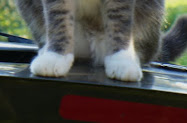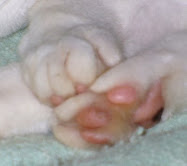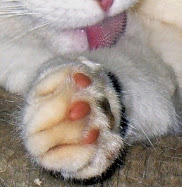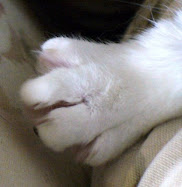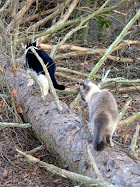 Isn't he pretty? He's a male three-toed terrapin or tortoise, a variation of box turtle. The males have this bright coloration on the head and neck. He looks just like the one I found...
Isn't he pretty? He's a male three-toed terrapin or tortoise, a variation of box turtle. The males have this bright coloration on the head and neck. He looks just like the one I found...A few days ago we had showers on and off after a month of dry weather. Whenever this particular weather pattern occurs, the turtles come out to cross the roads - and many never make it. Thursday I had already moved two turtles to safety when I spotted a third in the center of my lane. A car was close behind me as I slowed enough to realize this one had already been hit. I turned around to see if it was alive or dead, and saw it retract its head and front legs. The rear left quarter of its shell was broken and there was a gap of an inch with fat and flesh visible. The poor fellow was stuck to a 92 degree highway with his own dried blood. Eeeww.... Lucky for me I am not squeamish. I slid a scraper under him, then placed him in a plastic tub that usually holds cans of paint. I figured he'd likely die of shock and dehydration, but I took him on home and gave it a try. I disinfected the injury as best I could, gave him food and water and checked him frequently over the next several hours. By the time I realized he was pretty stable, it was Friday morning.
The job I was doing (painting a floor on a deadline) took over 12 hours and I had to go back on Saturday to finish. My turtle boy was now sporting a large band-aid to stabilize the broken shell. I had to do this as he kept banging around his container-home making the gap bleed. By the time I got home on Saturday, I all the the area Vets were closed, and of course I couldn't afford a vet bill anyway. I was supposed to go to the opening reception where I was showing work, but I couldn't not try to get my turtle some professioal help.
I called the University of Georgia in Athens, and the nice young veterinary student who was on call said to bring him over. It was a hundred mile drive round trip and I missed my opening, but it was worth it to hear that she (the doctor) thought he could be saved - barring any complications. They will release him in a nature sancuary when he is able.
 This is not a photo of the turtle in my tale - but this injury area is similar - and likely my turtle-boy now sports something like this. Non-toxic silicon adhesives with fiberglass reinforcement has been used successfully.
This is not a photo of the turtle in my tale - but this injury area is similar - and likely my turtle-boy now sports something like this. Non-toxic silicon adhesives with fiberglass reinforcement has been used successfully.I'm one of those dedicated turtle savers who will slow, hit the hazard lights, stop, and move turtles off the road in the direction they were headed, unless it's a particularly dangerous and/or unsuitable area, in which case I release them on my 40 acres. Apparently it's mostly male turtles seeking girlfriends who are out and about after a rain. Box turtles don't range far from the places they are hatched - usually not venturing outside of one square mile during the whole of their 50 + years. They do need to be near fresh water for cooling off and as a source of easily caught food., and eggs are often laid in soft or sandy soil adjacent to a pond or stream. By now there must be a healthy population hereabouts. Luckily I have two small ponds and a stream on my land.

Twenty years ago I had a wonderful turtle experience that gave me a love for these intelligent gentle creatures which I wrote about here.

